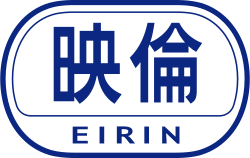Eirin
Eirin (映倫) is the abbreviated name of the Film Classification and Rating Organization (映画倫理機構, Eiga Rinri Kikō), Japan's movie regulator. Eirin was established on the model of the American Motion Picture Producers and Distributors Association's Production Code Administration in June 1949, on the instructions of the US occupation force. It classifies films into one of four categories, depending on their suitability for viewing by minors.
映画倫理機構 | |
 | |
| Pronunciation |
|
|---|---|
| Formation | June 1949 |
| Founder | Government of Japan by order of the Supreme Commander for the Allied Powers GEN Douglas MacArthur |
| Founded at | Japan |
| Type | self-regulatory |
| Purpose | Classifying films to indicate their suitability for minors |
| Headquarters | Chūō, Tokyo, Japan |
| Location |
|
Area served | Japan |
Description
As in other countries, Eirin classifies films to indicate their suitability for minors. It considers eight criteria, such as whether the film contains sexual or violent material, and give the film a rating in one of four categories.[1] Although the ratings are sometimes controversial, Eirin's defenders argue that its independence shields film makers from the more draconian alternative, government censorship.[2]
During the opening credits (or in some cases, on the copyright screen immediately following the ending credits) of an Eirin-approved film, the Eirin logo is displayed prominently underneath or beside the movie's title. Eirin has no legal power to ban films, but the Japan Association of Theatre Owners forbids its members from screening films that haven’t been classified by Eirin.[2]
History
During World War II the government of Japan censored films. The job of censoring was the responsibility of the Interior Ministry's Police Bureau. In time censorship was subsumed with the motions picture law of 1939. After the war's end, the General Headquarters of the Allied Forces who had occupied Japan, took on the role of movie-censor. In 1949 Japan's motion picture industry formed its own self-regulating organization which was based on the code of the Motion Picture Producers and Distributors of America, (which later became the Motion Picture Association of America.)
The Motion Picture Code of Ethics Committee (映画倫規程理管理委員会, Eiga Rinri Kitei Kanri Iinkai) was established in 1949 and was the predecessor to Eirin.[2] The organization was criticized for hiring examiners who were part of the very same movie industry that financed the organization. There was also criticism of the content of some films which came out at the time, such as Nikkatsu’s, “Season of the Sun” (“Taiyo no Kisetsu”) based on the award-winning book by Shintaro Ishihara.
In response to the criticism Eirin began to bring in outsiders to join the commission in 1956, and reorganized into a self-financing, independent body. At that time it also changed its name to Eirin Kanri Iinkai, and is the foundation of today's rating body.[2]
Ratings
Early ratings set
From 1976 to May 1, 1998, there were three rating categories:
- General Audiences (一般指定, Ippan Shitei) - Patrons of all ages are admitted.
- Limited General Film (一般映画制限付, Ippan Eiga Seigen-tsuki) - Patrons under 15 must be accompanied by a parent or guardian. The first Japanese film to use this rating was Ninkyo Gaiden: Genkai Nada (任侠外伝 玄界灘, Ninkyō Gaiden: Genkai Nada, released May 29, 1976) and the first non-Japanese film to use this rating was Snuff (released June 19, 1976).
- Adult Audiences (成人指定, Seijin Shitei) - Only adults are admitted.
Current ratings set
On May 1, 1998 four rating categories were introduced:[1] R15 and R18 are restricted categories and it is forbidden to admit an underage patron to a film with a restricted rating, rent, sell, exhibit DVDs or motion picture releases to underage patrons with restricted ratings. Such violations are a criminal offense and strictly enforced.
Unrestricted
- G: General Audiences. All ages admitted.
- PG12 (PG-12): Parental Guidance Requested. Some material may be unsuitable for children under 12. Parents are advised to accompany their children during the film.
Restricted
The R15+ and R18+ ratings are age restricted. All cinemas are legally required to check the age of all patrons who wish to view an R15+ or R18+ rated film. Admitting underage patrons to such films is considered a criminal offense and can be punished with fines/imprisonment.
- R15+ (R-15): Restricted to teenagers 15 and over only. Children and teenagers under the age of 15 are banned from viewing the film.
- R18+ (R-18): Restricted to adults 18 and over only. Children and teenagers under the age of 18 are banned from viewing the film.
See also
- Computer Entertainment Rating Organization – The Japanese rating system for video games
- Motion picture rating system
References
- "FILM CLASSIFICATION". eirin.jp.
- Martin, Alex (2010-03-02). "All movies subject to rating, even cuts". The Japan Times Online. ISSN 0447-5763. Retrieved 2017-01-30.
External links
- Official site (Japanese and English)
- http://www.midnighteye.com/interviews/kinji_fukasaku.shtml